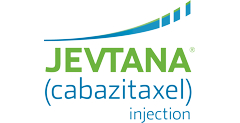Study Design
A large, international, randomized, open-label trial in patients (N=755) with mCRPC who previously received docetaxel. These patients were randomized 1:1 to JEVTANA® (cabazitaxel) injection (n=378) or mitoxantrone (n=377). The trial included patients with high disease burden and rapid progression after docetaxel.1,2
mCRPC=metastatic castration-resistant prostate cancer.
JEVTANA® (cabazitaxel) injection Sustained an Overall Survival (OS) Advantage in 2nd-Line Treatment of mCRPC at 2 Years vs Mitoxantrone1,3
Primary Endpoint: OS1-3
- 12.8-month follow-up: 15.1 months (95% CI: 14.1-16.3) median OS for patients receiving JEVTANA® (cabazitaxel) injection 25 mg/m2 vs 12.7 months (95% CI: 11.6-13.7) with mitoxantrone (P<0.0001). Number of deaths were 234 (62%) with JEVTANA® (cabazitaxel) injection vs 279 (74%) with mitoxantrone1,2
- 2-year follow-up: number of deaths were 350 (93%) with JEVTANA® (cabazitaxel) injection vs 366 (97%) with mitoxantrone1
- Due to study limitations, the 2-year advantage is the probability of survival with a data cutoff of March 20103
TROPIC Tumor Response Rate
JEVTANA Delivered a ≥30% Tumor Reduction in 3X More Patients With mCRPC vs Mitoxantrone1,2,4
Secondary Endpoint: Investigator-Assessed Tumor Response1,2
Percent of Patients
- Partial response was measured by RECIST criteria, which is defined as at least a 30% decrease in the sum of diameters of target lesions, taking as reference the baseline sum diameters2,4
- Patients treated with 25 mg/m 2 of JEVTANA® (cabazitaxel) injection received a median of 6 treatment cycles, with 28% of patients receiving 10 treatment cycles1,2
RECIST=Response Evaluation Criteria in Solid Tumors.
TROPIC Safety
Safety of JEVTANA + Prednisone (n=371) Compared to Mitoxantrone + Prednisone (n=371)1
-
Deaths due to causes other than disease progression within 30 days of last study drug dose were reported in 18 (5%) JEVTANA-treated patients and 3 (<1%) mitoxantrone-treated patients
- The most common (≥10%) grade 1-4 adverse reactions in patients who received JEVTANA vs mitoxantrone were anemia (98% vs 82%, respectively), leukopenia (96% vs 93%), neutropenia (94% vs 87%), thrombocytopenia (48% vs 43%), diarrhea (47% vs 11%), fatigue (37% vs 27%), nausea (34% vs 23%), vomiting (22% vs 10%), constipation (20% vs 15%), asthenia (20% vs 12%), abdominal pain (17% vs 6%), hematuria (17% vs 4%), back pain (16% vs 12%), anorexia (16% vs 11%), peripheral neuropathy (13% vs 3%), pyrexia (12% vs 6%), dyspnea (12% vs 4%), dysgeusia (11% vs 4%), cough (11% vs 6%), arthralgia (11% vs 8%), and alopecia (10% vs 5%)
- The most common (≥5%) grade 3-4 adverse reactions in patients who received JEVTANA vs mitoxantrone were neutropenia (82% vs 58%), leukopenia (69% vs 42%), anemia (11% vs 5%), febrile neutropenia (7% vs 1%), diarrhea (6% vs <1%), fatigue (5% vs 3%), and asthenia (5% vs 2%)
Important Safety Information
References: 1. JEVTANA Prescribing Information. Bridgewater, NJ: sanofi-aventis U.S. LLC. 2. de Bono JS, Oudard S, Ozguroglu M, et al; for the TROPIC Investigators. Prednisone plus cabazitaxel or mitoxantrone for metastatic castration-resistant prostate cancer progressing after docetaxel treatment: a randomized open-label trial. Lancet. 2010;376(9747):1147-1154. 3. Bahl A, Oudard S, Tombal B, et al; for the TROPIC Investigators. Impact of cabazitaxel on 2-year survival and palliation of tumour-related pain in men with metastatic castration-resistant prostate cancer treated in the TROPIC trial. Ann Oncol. 2013;24(9):2402-2408. 4. Eisenhauer EA, Therasse P, Bogaerts J, et al. New response evaluation criteria in solid tumours: revised RECIST guideline (version 1.1). Eur J Cancer. 2009;45(2):228-247.
.jpg)